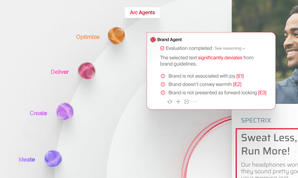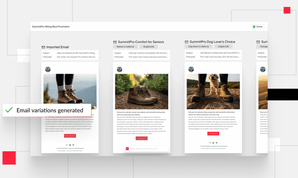AI at Work
Agentic AI and the Future of Intentional Work

Robert Rose · Chief Strategy Advisor | Content Marketing Institute
June 16th, 2025 · 7 min read

Earlier this month, I wrote a white paper for Typeface called Agentic AI and the New Era of Marketing.
It’s a piece I’ve been thinking about for a long time — because beneath the hype and headlines around artificial intelligence, I think we’re missing something essential. We’ve become so fixated on what AI can do for us that we’ve stopped asking what it might help us become.
Today’s post is a deeper dive on the topic and a reflection on a deeper shift that’s already underway. A shift away from task-based automation and toward something more meaningful: a redefinition of how we work, how we decide, and how we design the marketing systems around us.
At the center of that shift is the idea of AI-first workflows — but not the kind that just move faster. The kind that allow people to lead with judgment, creativity, and real choice.
The limitations of “do this for me”
Most AI today lives in the world of delegation. We ask it to write, summarize, tag, transcribe. These capabilities are useful — and sometimes remarkably good — but they’re mostly transactional. They compress time. They don’t transform thinking.
And while that can feel efficient, it isn’t always effective. The more we outsource, the more we risk losing connection to the strategy, context, and intention that give our work meaning in the first place.
The real opportunity isn’t in layering AI onto what we already do — it’s in designing workflows not just for automation, or even for agency for that matter, but for who we have the potential to become.
The three levels of maturity
To talk seriously about where AI is going, it helps to define what “maturity” actually looks like. In the paper, I refer to a concept of progressive levels of AI adoption. Each one reflects a different mindset about what AI is for — and who it’s meant to empower.
Level One: Task automation
This is where most organizations begin — and where many still operate. At this stage, AI handles discrete tasks: scheduling meetings, answering basic queries, cleaning up transcripts. It’s all about saving time and reducing costs.
But while automation can lighten the load, it doesn’t elevate the work. The human role stays the same — just slightly less burdened. The workflow doesn’t evolve. It just speeds up.
Level Two: AI-first workflows
At this level, things start to shift. AI becomes part of the system itself. Data flows between tools. Content is repurposed more intelligently. Campaigns are managed with more precision.
Here, content and marketing operations stop being rigid or siloed. They become modular — a flexible foundation where AI agents, tools, and workflows can plug in, coordinate, and improve together.
The work becomes more efficient and coordinated. But the structure still revolves around predefined steps. The human remains mostly reactive — responding to what the system enables, not shaping what it could become.
Level Three: Agentic workflows
This is where things get interesting.
Level Three isn’t about having a dashboard that automates. It’s about building a system of coordinated intelligence — modular, responsive, and designed to empower people at scale.
In a mature AI-first workflow, multiple agents work together, just like a well-functioning marketing team. One might handle content generation, another compliance, a third visual assets. Each is optimized for a different role, but it’s their coordination that unlocks true scale and sophistication.
This goes well beyond subject lines and ad copy. Agentic systems can generate video scripts, assemble product carousels, tag and route visual assets, and reformat content for multiple channels — all while staying aligned to brand and compliance standards.
But none of that works unless the AI ecosystem integrates with the rest of your stack. CRM, CMS, analytics, email, DAM — everything must speak the same language. This isn’t about ripping and replacing what works. It’s about layering in intelligence that makes it all work better, together.
Governance, too, has to be built in — not bolted on. Role-based permissions, approval flows, brand voice enforcement, auditability — these aren't optional. They're essential. Confidence is what turns experimentation into scale.
And finally, for any of this to be truly strategic, it must be customizable. Every team has its own workflows, taxonomies, success metrics. The best systems reflect that individuality and adapt to how you work — not the other way around.
Put simply: Level Three isn’t about having the best tool. It’s about building the smartest system.
What to look for in an agentic AI system
If the maturity model tells you where to go, the next question is: What does a good AI-first workflow system actually look like?
At a high level, the answer is clear: it’s not rigid. It’s modular.
The most effective platforms won’t be locked into linear workflows or generic tooling. They’ll act as adaptive foundations — letting agents, tools, and teams plug in, collaborate, and evolve together over time.
Here’s what to look for:
Multi-agent collaboration: No single model should do it all. Like any team, your AI system should include different agents optimized for different roles — and they should work together seamlessly.
Multimodal content creation: Agentic AI doesn’t live in one format. It operates across text, video, imagery, and interaction — assembling, adapting, and activating content in the medium that fits the message.
Native integration: AI can’t drive strategy if it’s stuck in a silo. The best systems integrate across CMS, DAM, analytics, CRM, email, and social tools — turning AI into a fabric of how we operate, not a disconnected tool.
Built-in governance and brand safety: Trust is essential. Role-based permissions, approval flows, voice enforcement, and auditability aren’t just features — they’re foundational.
Strategic customization: Your AI should reflect your brand. That means the ability to tune systems to your taxonomies, KPIs, workflows, and ways of working — so outputs feel aligned, not off-the-shelf.
Ultimately, what separates useful AI from empty hype isn’t the model — it’s the architecture. The organizations seeing real value from AI are the ones redesigning workflows, embedding governance, and shaping intelligence to fit their people, not just their processes.
With the right foundation, AI becomes more than an assistant. It becomes a strategic engine.
Smarter systems, wiser teams
Marketing has gotten faster. But this speed often comes at the expense of thoughtfulness and intention.
Despite the rise of automation, dashboards, and performance metrics, the work itself still feels fragmented — stuck in handoffs, slowed by inconsistency, and often weighed down by its own complexity.
An AI-first workflow approach addresses this not by replacing human judgment, but by creating space for it. It turns systems into collaborators. It helps carry forward the creative intent behind the work, and enables teams to navigate complexity with more confidence and clarity.
The teams that thrive won’t be the ones with the flashiest tools. They’ll be the ones with the strongest connective tissue:
Workflows that are structured but adaptable
Platforms that are modular and integrated
People who are supported, not sidelined
It’s about giving marketing the room to focus on what truly differentiates: strategy, storytelling, creativity, and human insight. It’s not about surrendering control. It’s about building systems that think with you.
Not a race to move faster.
A return to moving with intention.
--
If this resonates — if you're building systems, leading teams, or simply rethinking how AI fits into your work — I invite you to go deeper. The full paper and our recent webinar explores the framework in more detail, including real-world adoption models and reflections on how to build agentic systems that work in practice — not just in theory.
Tune into the recent webinar, “Marketing With Intent: The Strategic Power of AI”
Share
Related articles

AI at Work
AI Design: Quality Benchmarks and Best Practices

Akshita Sharma · Content Marketing Associate
June 12th, 2025 · 14 min read

Product
Typeface Introduces the New AI-Native Content Lifecycle, Powered by Deeply Specialized Marketing Agents and a Dynamic Brand Hub

Abhay Parasnis · Founder and CEO
March 11th, 2025 · 8 min read

Product
What’s new in Email Agent: A unified workflow to create and manage personalized email variations

Anika Gupta · Product Manager
April 30th, 2025 · 5 min read